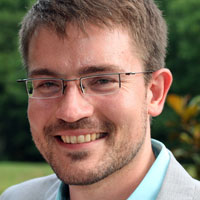More tobacco retailers in LGB neighborhoods may explain smoking disparities
March 5, 2015
Same-sex couples are more likely to live in areas that have high levels of access to tobacco products, according to researchers from the UNC Gillings School of Global Public Health.
The study – “Is there a relationship between the concentration of same-sex couples and tobacco retailer density?” – published online March 5 in the journal Nicotine & Tobacco Research, was conducted by Joseph G. Lee, MPH, doctoral candidate in health behavior at the Gillings School. The work is the first to suggest that the role of stores selling tobacco contributes to the fact that lesbian, gay and bisexual (LGB) people use tobacco more than heterosexual people.
The prevalence of tobacco use is high among LGB people — 36 percent of LGB adults use tobacco, compared with 24 percent of heterosexuals, according to the 2012-13 National Adult Tobacco Survey. Using a list of tobacco retailers in 97 U.S. counties, Lee and his colleagues calculated the number of tobacco retailers per 1,000 people and the rates of same-sex couples per 1,000 households in census tract neighborhoods. Data on same-sex couples came from the 2010 U.S. Census.
Lee found higher rates of same-sex couples in neighborhoods where the density of tobacco retailers per person is greatest. Because having a store nearby reduces the effort needed to purchase tobacco products, greater density of stores near a tobacco user’s home can have an impact upon health. Having more stores that sell tobacco products provides more marketing cues for impulse purchases. Proximity to tobacco retailers may make it harder to quit smoking.
The health risks of tobacco use are well known. Lee’s study notes that, as a population, same-sex couples live in areas with more tobacco retailers, and this could influence health disparities.
Much of the literature on tobacco dependence disparities for LGB populations is based upon a minority stress model. Lee’s study suggests another contributing factor — neighborhood environment — also may contribute to the disparities. Future research should identify ways to limit density of tobacco retailers in order to help reduce tobacco use and help LGB smokers quit.
Joining Lee in the research were Kurt Ribisl, PhD, professor of health behavior at the Gillings School, and Adam Goldstein, MD, MPH, professor of family medicine in UNC’s School of Medicine, as well as William Pan, DrPH, assistant professor of global environmental health at Duke University, and Lisa Henriksen, PhD, senior research scholar in Stanford University’s School of Medicine.

